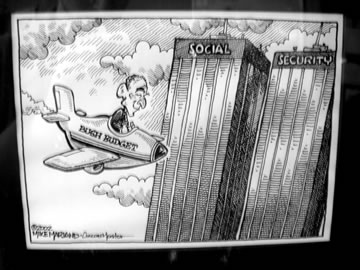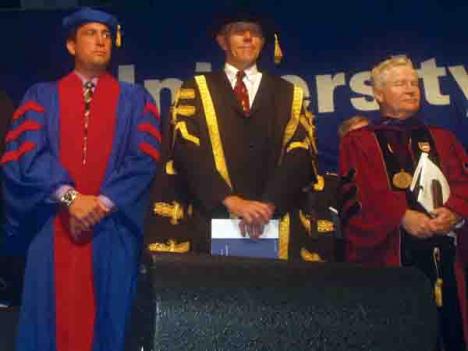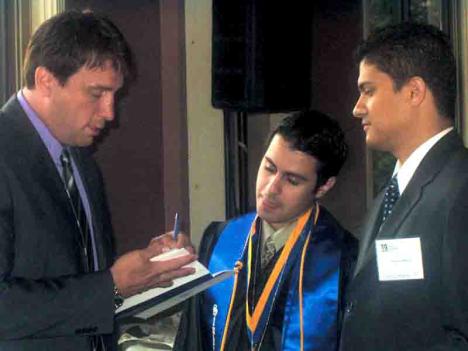The Politics of Perspectives

Mike Marland depicts Bush?s stance on Social Security. – Photo by Jason Campos
May 8, 2003
On May 3, 2003, Joshua Anygeorge visited UMass Boston to communicate his experiences as a detainee in the Elizabeth Detention Center in the post-September 11 political climate. As an immigrant from Sierra Leone in West Africa, he fled after losing his family and possessions to a 10-year-old ongoing civil war.
Arriving illegally December 6, 2000 at Newark International Airport with nothing but the blood-stained shirt on his back, he was held indefinitely while the authorities to looked further into his need for asylum to determine whether or not it was legitimate.
Anygeorge had no family, unlike most of the other inmates, so for 5 months he lived with extreme anxiety that he might be sent back and an uncontrollable loneliness for the family he had lost. Through suicidal fantasies and nearly complete and total despair, he managed to survive and channel his unhappiness into a series of poems describing the feelings and experiences that haunt him.
We saw the pain of his memories in a number of pieces he shared with a rapt audience at the conference held by the Human Rights Working Group and the College of Public and Community Service debating whether it was a “War on Terrorism or Assault on Human Rights?” With several other refugees telling their tales of Patriot Act persecution, Anygeorge’s poetry impacted many, including himself when he says, “Everyone want to live forever but sometimes you long for death” in a country that he ironically describes as “the land of freedom and peace,” a solemn reminder of just how exacting the price for the former and the latter can be.
In “Ambiguity,” Anygeorge speaks of longing for a home he can no longer return to and how it seems to be a better alternative to the crushing and sterile loneliness of Elizabeth detention center. “Life has walked away from me/incarceration walks me into the darkest path of my life/I’m lost, from home.” However, before he could finish his last poem “Sullen Fever,” Anygeorge was overcome by emotion and was unable to continue reading, forcing an off-guard Chuck Turner, a member of the Boston City Council, to start his speech somewhat early.
That was not the only display of creativity inspired by current events. The USA Patriot Art Show, confined to the Ryan Lounge, featured political cartoons ranging from caustic to downright offensive as they were found to be by reactionaries still reeling from the shock of 9/11.
Mike Marland, political cartoonist, submitted a work for the February 8, 2002 edition of the Concord Monitor depicting Bush in a plane flying towards two towers, an obvious comparison to the destruction caused to the World Trade Center, labeled “social” and “security.” The extreme parallels drawn between the two caused a public furor and Marland was dropped from the Concord Monitor, though not because of outraged readers but for financial reasons that happened to coincide with the upset, leading many to assume the first was the true motive. He was reinstated after only a week after his cartoons had been dropped from three other New Hampshire weeklies.
Among those featured in the display was Pulitzer Prize-winning cartoonist Clay Bennett of the Christian Science Monitor, showing a house, labeled “privacy,” in the process of having its boards removed and used to build a fence called “security,” an overt reference to the liberties taken by the government with the Office of Homeland Security.
A common theme seems to be that of Lady Justice or the Statue of Liberty being tied down and blindfolded or ready for sacrifice in a weird sort of political S&M with Bush or Ashcroft usually depicted as the torturer or, in some cases, the executioner in the Philadelphia Inquirer’s November 31, 2001 issue.
I found Marland’s work to be overkill in the sense of the similarities it was trying to draw between the 9/11 and social security, but it did get me thinking about free speech and censorship. One of the fundamental principles of this country is the First Amendment and the right to say or express how you feel in any way. Where does art fall when so many people are upset by it? I didn’t care for his comparison because I felt that it smacked of a kid trying to get a rise out of his parents.
Yet, perhaps that was part of the reason he resorted to such graphic implied violence because he wanted a strong reaction. Although I didn’t like it, I wouldn’t want him to be fired and threatened as he was after the piece was published. Several of these cartoonists were dropped or found the safety of their lives, families, and jobs in doubt. You may not want to hear what has to be said, but is the alternative of silencing dissent any better?
The arts have provided both an outlet and way to question the mainstream political opinions and structures, using methods ranging from outrageous to abstract, providing a very clear view of just what the artist thinks sometimes with little or no obvious statements. Anygeorge’s poetry pushed some to tears while the cartoons caused mixed reactions of anger and amusement. It is both the ambiguity and ability to provoke reactions that make the work so compelling when placed in the context of a worried and harried nation such as ours.






















































